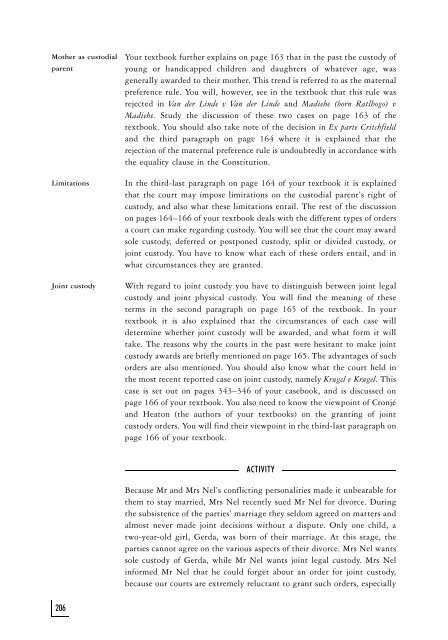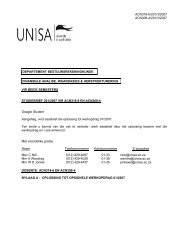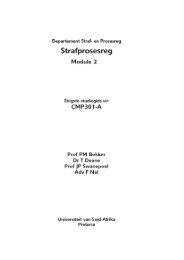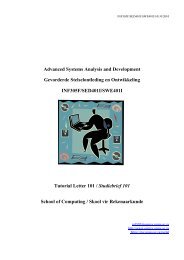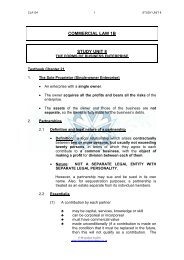key to the study guide - Name
key to the study guide - Name
key to the study guide - Name
You also want an ePaper? Increase the reach of your titles
YUMPU automatically turns print PDFs into web optimized ePapers that Google loves.
Mo<strong>the</strong>r as cus<strong>to</strong>dial<br />
parent<br />
Your textbook fur<strong>the</strong>r explains on page 163 that in <strong>the</strong> past <strong>the</strong> cus<strong>to</strong>dy of<br />
young or handicapped children and daughters of whatever age, was<br />
generally awarded <strong>to</strong> <strong>the</strong>ir mo<strong>the</strong>r. This trend is referred <strong>to</strong> as <strong>the</strong> maternal<br />
preference rule. You will, however, see in <strong>the</strong> textbook that this rule was<br />
rejected in Van der Linde v Van der Linde and Madiehe (born Ratlhogo) v<br />
Madiehe. Study <strong>the</strong> discussion of <strong>the</strong>se two cases on page 163 of <strong>the</strong><br />
textbook. You should also take note of <strong>the</strong> decision in Ex parte Critchfield<br />
and <strong>the</strong> third paragraph on page 164 where it is explained that <strong>the</strong><br />
rejection of <strong>the</strong> maternal preference rule is undoubtedly in accordance with<br />
<strong>the</strong> equality clause in <strong>the</strong> Constitution.<br />
Limitations In <strong>the</strong> third-last paragraph on page 164 of your textbook it is explained<br />
that <strong>the</strong> court may impose limitations on <strong>the</strong> cus<strong>to</strong>dial parent's right of<br />
cus<strong>to</strong>dy, and also what <strong>the</strong>se limitations entail. The rest of <strong>the</strong> discussion<br />
on pages 164±166 of your textbook deals with <strong>the</strong> different types of orders<br />
a court can make regarding cus<strong>to</strong>dy. You will see that <strong>the</strong> court may award<br />
sole cus<strong>to</strong>dy, deferred or postponed cus<strong>to</strong>dy, split or divided cus<strong>to</strong>dy, or<br />
joint cus<strong>to</strong>dy. You have <strong>to</strong> know what each of <strong>the</strong>se orders entail, and in<br />
what circumstances <strong>the</strong>y are granted.<br />
Joint cus<strong>to</strong>dy With regard <strong>to</strong> joint cus<strong>to</strong>dy you have <strong>to</strong> distinguish between joint legal<br />
cus<strong>to</strong>dy and joint physical cus<strong>to</strong>dy. You will find <strong>the</strong> meaning of <strong>the</strong>se<br />
terms in <strong>the</strong> second paragraph on page 165 of <strong>the</strong> textbook. In your<br />
textbook it is also explained that <strong>the</strong> circumstances of each case will<br />
determine whe<strong>the</strong>r joint cus<strong>to</strong>dy will be awarded, and what form it will<br />
take. The reasons why <strong>the</strong> courts in <strong>the</strong> past were hesitant <strong>to</strong> make joint<br />
cus<strong>to</strong>dy awards are briefly mentioned on page 165. The advantages of such<br />
orders are also mentioned. You should also know what <strong>the</strong> court held in<br />
<strong>the</strong> most recent reported case on joint cus<strong>to</strong>dy, namely Krugel v Krugel. This<br />
case is set out on pages 343±346 of your casebook, and is discussed on<br />
page 166 of your textbook. You also need <strong>to</strong> know <strong>the</strong> viewpoint of CronjeÂ<br />
and Hea<strong>to</strong>n (<strong>the</strong> authors of your textbooks) on <strong>the</strong> granting of joint<br />
cus<strong>to</strong>dy orders. You will find <strong>the</strong>ir viewpoint in <strong>the</strong> third-last paragraph on<br />
page 166 of your textbook.<br />
206<br />
ACTIVITY<br />
Because Mr and Mrs Nel's conflicting personalities made it unbearable for<br />
<strong>the</strong>m <strong>to</strong> stay married, Mrs Nel recently sued Mr Nel for divorce. During<br />
<strong>the</strong>subsistenceof<strong>the</strong>parties'marriage<strong>the</strong>yseldomagreedonmattersand<br />
almost never made joint decisions without a dispute. Only one child, a<br />
two-year-old girl, Gerda, was born of <strong>the</strong>ir marriage. At this stage, <strong>the</strong><br />
parties cannot agree on <strong>the</strong> various aspects of <strong>the</strong>ir divorce. Mrs Nel wants<br />
sole cus<strong>to</strong>dy of Gerda, while Mr Nel wants joint legal cus<strong>to</strong>dy. Mrs Nel<br />
informed Mr Nel that he could forget about an order for joint cus<strong>to</strong>dy,<br />
because our courts are extremely reluctant <strong>to</strong> grant such orders, especially


